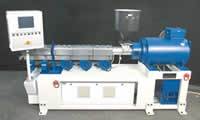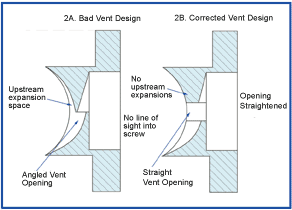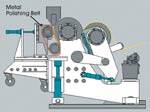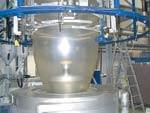Film Extrusion
NPE News Wrap-Up: Extrusion
Gearless extrusion, cryogenic profile calibration, wireless data communications, and automatic start-up of blown film lines are just a few of the new ways to raise efficiency and output that were highlighted at NPE.
Read MoreHow to Fix Vent-Flow Problems
Putting one or two vents between the feed throat and die is a good way to remove moisture, trapped air, and other volatiles from melted plastic as it moves through an extruder.
Read MoreA Show Full of Surprises For Every Application
It doesn’t matter whether you extrude blown or cast film, sheet, pipe, profiles, or foam—the K 2001 show held something exciting and unexpected that will open your eyes to new possibilities.
Read MoreNew Specialty Polymers Improve Fuel-Cell Economics
Recently formed alliances of fuel-cell start-up companies and engineering-polymer suppliers are already bearing fruit. Their research is coming up with new ion-conducting plastic films for use in Proton Exchange Membrane (PEM) fuel cells. These novel membranes are said to generate electric current more easily, operate across a broader temperature range, and cost less than the incumbent materials, which are mainly sulfonated fluoropolymers.
Read MoreBoltless Flat Die Opens Faster
Without changing the inner workings of the die, Extrusion Dies Inc., Chippewa Falls, Wis., has come up with a revolutionary way to assemble flat dies without bolts. The closing mechanism replaces conventional die bolts with rods actuated by hydraulic toggles to hold the die halves together.
Read MoreMulch Film Goes High-Tech
Mulch films come in a dazzling array of colors and multi-layered structures designed to manipulate light, temperature, and moisture and repel insects. But high-tech films are expensive and have found only niche markets so far. Processors now think coextrusion, downgauging, and better field testing can put this market on a fast-growth track.
Read MoreNanocomposites Broaden Roles in Automotive, Barrier Packaging
Nanocomposites are gradually gaining acceptance in the mainstream of global plastics processing. These polymer compounds, containing relatively low loadings (under 6% by weight) of nanometer-sized mineral particles, are beginning to show up in polypropylene and TPO-based automotive exterior claddings, barrier beer bottles, nylon packaging films, polyethylene pipe and wire/cable coatings, and more.
Read MoreExtrusion (K 2001 Preview)
Probably the most intriguing news in extrusion at K 2001 will be a novel way to extrude clear film that differs from standard blown and cast methods.
Read MoreLCPs Break New Ground in Film Coextrusion and Thermoforming
Liquid-crystal polymer extrusion resins cost over $10/lb, but when used sparingly in 2-5 micron layers, they can be cost-effective in barrier packaging films.
Read MoreMetallocene PP & PE Weld Strongly to Each Other
Multilayer film applications such as packaging and diapers are just two areas that could benefit from spot welding (instead of gluing) polyethylene to polypropylene. Normally these two resins show poor adhesion to each other. But two years of research at the University of Minnesota in Minneapolis and at ExxonMobil Chemical in Houston show that metallocene-catalyzed polyolefins can weld to each other with bond strengths much greater than are possible with conventional Ziegler-Natta catalyzed polyolefins.
Read More


















